- Home
- Nicholson Baker
The Anthologist Page 12
The Anthologist Read online
Page 12
And one day Ginsberg was giving a talk at the Naropa Institute, where he taught, and somebody asked him what the real rhythm of his poetry was. He was in the middle of saying how bad it was for children to be taught traditional meters—the kind his father used—how the bad iambic rhythm warped their little pure Buddha minds. And somebody at the Naropa Institute said, Well then, tell us, Allen. What is the real rhythm of poetry? And Ginsberg replied that the rhythm of poetry was the rhythm of the body. He said that it was, quote, “jacking off under bridges.”
And everyone went, Oh ho, chortle, provocative, ho. Because Ginsberg’s referring to jacking off under bridges and that’s humorous. And it is, frankly. In fact I really like that Ginsberg would say that. It’s the kind of refreshing thing that only he and some of the Beats were able to say.
So yes. Except that it isn’t true. Because—try it. Just try to imagine standing under a bridge somewhere, holding a copy of Howl. Paperback copy.
You’re under a bridge and you’re holding your copy of Howl, and you read: “I saw the best minds of my generation zonked out on angry Koolaid in the junky slums of West 83rd street, dah dah dah dah dah dah dah dah—” Help! You can’t get anywhere with that. Nobody can.
THE REAL RHYTHM of poetry is a strolling rhythm. Or a dancing rhythm. A gavotte, a minuet, a waltz. Remember those inner quadruplets I mentioned? When each beat is divided into four little pulses? Sixteenth notes, they’re called, in music. Not duplets, not triplets, but quadruplets. Tetrasyllables. Some meter people call this the paeonic foot, after Aristotle. There’s a useless term for you. But listen to the way they can sound:
Love has gone and left me and I don’t know what to do
That’s Edna St. Vincent Millay. Still four beats, but each beat has four inner fuzz-bursts of phonemic energy.
Sara Teasdale did quadruplets, too:
Hear it? People always say that this quadruplet rhythm is for light verse. It doesn’t have to be, but it can be. Listen to this four-beater.
That’s light verse by Mr. Newman Levy. One of the lesser Algonquinites. Wrote a number of poems about alcohol, as befits a poet of the Prohibition, using that same quadruplet rhythm. Notice there’s no rest on the third line, just as in a traditional ballad. W. S. Gilbert, of Gilbert and Sullivan fame, also uses it—“He’s a modern major-general.” And A. A. Milne:
When the War is over and the sword at last we sheathe,
I’m going to keep a jelly-fish and listen to it breathe.
And Thomas Bailey Aldrich: “And the heavy-branched banana never yields its creamy fruit.” Vachel Lindsay used it: “Where is McKinley, that respectable McKinley”—hear the sixteenth notes in “respectable McKinley”? T. S. Eliot used it, under Vachel Lindsay’s influence. “Macavity Macavity there’s no one like Macavity.” Rappers use it a lot—
That’s by Ludacris. And Kipling used it a lot, and Poe used it, too. Poe’s “Raven,” which is probably the best quadruplet rhythm ever written—listen to it slowly:
And the silken, sad, uncertain rustling of each purple curtain
Isn’t that smooth?
Four very slow striding beats, with four steady silken swells filling each one. It’s so simple and so hypnotic.
And the metrists don’t know what to do with it. Here’s what one introduction to poetry says. A good introduction by John Frederick Nims. He says that Poe’s “Raven” is written in—ready?—“trochaic octameter with lines two and four catalectic.” Catalectic meaning cut short. And how far does that get you? It actually disables any understanding of the poem to say that what he’s doing is trochaic octameter. Because it’s still really a basic four-beat stanza. Poe chose to set it in a different way because the lines came out long, but it’s just a ballad. He said so himself. Poe is just taking a certain kind of beautiful stroll. Whether or not he stops under a bridge is not for us to say.
I WENT TO A BEAD STORE in town, and I bought some wire and a clasp and a clamping tool. I’ve decided to make some of the raw beads I bought for Roz into a real string of beads and give them to her. Not as an aggressive gift, but just as a friendly gift, to thank her for helping me when my finger was bleeding. I’ve learned to type without using my finger, by the way. Sometimes I type “dinger” for “finger” and “invlude” for “include.”
So I went to the bead store in town—Beadle Bailey, it’s called. It was very quiet inside. There were thousands of beads in tiny plastic cells, and I was amazed by the choices, the profusion of possibilities. It was like being a poet in that you had indivisible units that you could string together in certain rhythms. You can’t alter the nature of a given bead, or a given word, but you can change which bead you choose, and the order in which you string them on their line. And I wanted to string together the beads I chose as a gift, which meant I had a certain person in mind when I looked at the colors. I was looking at the colors with Roz’s color sense in my eyeballs. And I had an ideal in mind of rhythm and of randomness. Other beaders were bending, staring into the containers, or looking at the strings of beads hanging from metal hooks on the wall.
I saw some dusty pale small ceramic beads, and I felt the immediate clench of knowing that these were the ones that Roz would like best mixed with the ones I already had from Second Avenue. I asked the beadseller at the register about clasps, and it turns out that you can buy a certain kind of magnetic clasp that frees you from the problem of fitting tiny spring-loaded hooks together. The beadseller put on her reading glasses—she had them on a black-and-yellow beaded string—and she said, “I love these,” pointing to one of my selections. She put the singles in a little plastic bag, and the strings, too. The whole purchase went into a pale green paper bag, and I walked out blinking onto the street carrying the raw materials for my present to Roz and feeling a joy of knowing that I was going to make something for her—something like a poem, but better than any poem I could write.
I think I’ll do a quadruplet rhythm, a love-has-gone-and-left-me rhythm: one gray-green bead and then three other beads of near-random colors, and then a gray-green bead again.
11
I LOOKED FOR AN HOUR for a certain file in my office and couldn’t find it. I found many things that I should have acted on a long time ago and have not. I found nice letters— unanswered letters, which cause searing guilt beyond all imagining. Also bound galleys of books of poetry from editors hoping for a blurb. Unread and unacknowledged. These bring less guilt, but some, because how hard would it have been to write the editor and explain?
I didn’t find the file I was looking for, which holds the drafts of my flying spoon poems. These have swerved in and out of my life for so many years now that I have quite a fat file. The file now stands for the reality. I thought, If I don’t find this spoon file I won’t be able to write the poem that I was put on this earth to write and my life will have been in vain.
I sprawled in bed grieving for the loss of this file, although I knew it wasn’t lost but was somewhere in my office. And then I saw that the only chance I had of writing a half-decent spoon poem was in not finding the file. As soon as I had the file in hand it would smother any new upwellings I might have. I felt released from a heavy burden and I lay in bed blinking at my good fortune. Then my eye moved in a great arc across the ceiling and down the wall across the room. I saw a pile of books that I’d forgotten about, stacked leaningly under a table next to a bookcase. At the bottom of this pile was a folder about an inch thick. I knew from the familiar position of the blue Post-it notes projecting from it that it was the spoon file.
I drove to the John Greenleaf Whittier house in Haverhill, Massachusetts, and joined the tour.
WHITTIER WAS A NINETEENTH-CENTURY POET who wrote a once-famous four-beater about a blizzard, called “Snow-Bound.”
On the tour, I sat down in a rocking chair that Whittier sat in. I saw the minuscule stock of books he had in the house when he was a boy, and the poem he wrote about them. It was the tour guide’s last day, and she gave our little gr
oup—a family of three, a silent woman, and me—her best shot. She brought out the funny bits and the sad bits and showed us the china and the linen and told us about the yarn weasel in the guest room. You crank this weasel to measure out how much yarn you’ve spun—it keeps track by counting the number of clicks it makes, one click for a certain number of crankings. Hence “Pop Goes the Weasel,” a poem with interesting nineteenth-century off-rhymes—“needle,” “weasel”—and a surprising number of verses, because you recited it while cranking, and I guess there was a lot of yarn to measure.
Most of Whittier’s poetry wasn’t good, the tour guide told us. It was tedious, often, and there was too much of it. But his life was good. He’d spent eighteen years writing and editing antislavery newspapers. Once the office of a newspaper in Philadelphia was stormed by a proslavery mob. Whittier, who was the editor of the paper, stole away and put on a wig and a different outfit and joined the looters in the building. They reached his office, calling, Where’s Whittier? Where’s that whoreson slimedog Whittier? He broke into his office with them and was able to loot his own papers to safety before they set fire to the building. It was after the Civil War that he wrote “Snow-Bound.” Which is extremely long, but has several good moments.
The tour guide almost got tearful at the end of the tour, while she sold me a postcard of the room we stood in. Her Ford Mustang was for sale, parked on the grass. She was going west to work for the State of Kentucky.
I DROVE HOME from the Whittier house, and as I drove I thought about Whittier versus Longfellow. The two American G-rated graybeards. Longfellow was the greater poet, of course. A strange sad man who lost two wives and a child. He wrote a good poem called “The Day Is Done.” Here’s its first stanza. I came up with a tune for it:
Hear those mixed rhythms? That poem was the preface to an anthology Longfellow published in 1848, called The Waif. The anthology drove Edgar Allan Poe mad with grief and rage and spite. Why? Because it was a fancy, expensive Christmas present of a book, a book of the North, and Longfellow hadn’t included any of Poe’s own poems. Poe had written Longfellow fan letters—and then he was left out of The Waif. Left out on purpose, Poe believed. And Poe was right. In his review of the anthology, Poe said that Longfellow had deliberately omitted the American writers he owed so much to. And then Poe went on a crusade, charging Longfellow with theft, writing pseudonymous letters. Longfellow’s rejection had pushed him over the edge.
And yet it was all for the best, perhaps. Out of those feelings of miserable exclusion and persecution and lucklessness, Poe wrote “The Raven.”
I got home and sat in the kitchen staring at an empty bowl. Paul Chowder’s bowl of poetry.
WHAT I’M STARTING to realize is that I don’t want a bowl of poetry. I want, more than anything, a bowl of cold potato salad with bits of parsley in there and the skins of the potato and the flesh of the potato but somewhat confused by the presence of the mayonnaise. I want to own a summer-sized drum of mayonnaise. Roz always used to buy a double-big jar of Hellmann’s mayonnaise to celebrate summer. I want there to be cold potato salad in the empty bowl. Roz’s potatoes held the cold of the fridge inside them, like chewable ice cubes. But there isn’t any potato salad.
The mouse came out about ten-thirty p.m. I was still sitting at the kitchen table and I heard a tiny rattle and I saw him climb into the box made of squashed pulp that held the last stalk of blueberries. I’d picked one bunch of unripe blueberries on their stems in order to remember the different colors they have before they turn smoky blue. There are pale greens and pale pinks—Rubensesque colors that you don’t expect blueberries to have because you think of blueberries as these smoky heavy bosomy black things in leaf shadow waiting to be plucked. But they’re very light and green and springlike in their unripeness. And then they ripen and turn blue-black and finally go all wrinkly and raisinous. The mouse emerged from the stove and did his funny jerky rushing worried progress, branching here and there, retreating, advancing, and finally he made it across past the baking-soda box and the detergent bottle and up on the splash guard, and then he went down into the sink, and up from there into the drainer, and then he climbed into the pulp box and found the bunch of blueberries inside, and he dragged it back up into the stove.
When he came out again I tried to catch him with a plastic pitcher, but he climbed up the curtain and ran along the curtain rod and got away.
Here’s the tune I made up for Poe’s “Raven.” It goes:
Raymond helped me disassemble the bed in Nan’s guest room and move it out, and I went to Home Depot and strapped several hundred dollars’ worth of pine planks to the roof rack. I bought a new saw blade, and flooring nails with long spirals graven into them so that they’d grip the subfloor better. I felt full of joyful purpose. A floor is a permanent thing. I was putting in a floor for my neighbor Nanette, and getting paid for it.
My finger bothered me a little bit when I was getting a nail started, till I learned to hold it a different way, the way somebody—maybe William Holden—smoked a cigarette. Raymond turned out to have a knack for carpentry. As did Nan, in fact. The three of us stapled down a layer of blue sheeting over the subfloor, and Nan cut around the edge with a retractable knife as if cutting off the excess of a piecrust. Then the planks started going in. We nailed all afternoon. We drank lemonade and talked about zombie movies, and zombie novels, and zombies in video games, and then we nailed some more. Raymond got his music player going, and we sang “Zombie Jamboree.” I pointed out the off-rhyme in the song: “belly to belly” and “stone dead already.” They were mildly interested. I also made a few mistakes of measurement that Nan saved me from. She had a good spatial sense, which carried us successfully through the tricky area around the bathroom door.
Chuck, Nan’s boyfriend, appeared late in the afternoon, and I got him a hammer and a cupful of nails and he nailed, too, for a while. He was a perfectly decent guy. He is an engineer who works at the Navy Yard in Kittery caring for nuclear-powered submarines. He and his friends pull the nuclear engines out and change their spark plugs and bang their carburetors with wrenches and then slide the engines back in place. With Chuck there we talked about fractions of an inch and acceptable degrees of gap between boards, and we politely debated which length of board to use next.
When we were almost done I paused, sprawled on my elbow on the floor, thinking about the song of the nails. There were four hammers going now, each with a different speed of hammering. A nail starts by sounding low because there’s more length of nail to vibrate, but as more and more of it disappears into the wood, its pitch gets higher and more strained. It goes bong, bang, bing, bink. And then, at the very end, just after the highest-pitched note, there are two or three confident wide low smacks when the nailhead has touched down and you’re hitting the whole floorboard—whang, whang, whang. We all wanted to sound like good nailers, and we all did sound like good nailers—and I think we were content in the midst of that happy racket.
Just before I left, Chuck asked me why I was publishing an anthology of rhyming poems.
“It seemed like it would help somehow,” I said.
Chuck said, “Are you making a statement? Are you saying that free verse is a bad thing?”
I said no, I didn’t think I was, not really. My own poems were free verse, after all. But then again my own poems sickened me, so I was confused.
“Are you editing the anthology out of self-hatred?” Chuck pursued.
I smiled. “Yes, Chuck, I think that’s it.”
“What’s the best poem ever written?” asked Nan.
I told her I couldn’t answer that. “One poem I liked recently was James Fenton’s ‘The Vapour Trail.’ “
“ ‘The Vapour Trail,’ “ said Chuck. “I’ll check it out.”
Nan walked me out to the deck and wrote out a check. What a nice sound it was to hear her tearing it out of her checkbook, while the frogs chirred away.
“I hear you singing in the barn sometimes,” s
he said.
“Oh, sorry,” I said.
“Roz told me she was at her wits’ end because you were up in that barn for weeks singing away, not writing.”
“Yes, but I’m doing better now. I’d like her to come back. If you talk to her, will you let her know that?”
“Sure,” said Nan. “Thanks for the floor.”
I WOKE UP after a nap. It was dark and very late. I found a pen and turned to the back of Mary Oliver’s book of poems, and I wrote: “People I’m jealous of.” I wrote:
—James Fenton
—Sinead O’Connor
—Lorenz Hart
—Jon Stewart
—Billy Collins.
“Billy” Collins, indeed. Charming chirping crack whore that he is. No, that’s incorrect—I know nothing about him. I know only my own jealousy. I’m not jealous of Merwin, though, and I’m not jealous of Mary Oliver. And I’m not jealous of Howard Moss. And I’m not jealous of Elizabeth Bishop. They’re beyond all jealousy.
Yes, I wish I were a different person. Yes, I’m attacked by my embarrassments that are like those flying antibodies in Fantastic Voyage that glue themselves to the bad man’s face when he swims out of the arterial spaceship. Yes, I sometimes have terrifying dreams in which a cat I’ve never seen before attacks a mouse and bites it and bites it, until I can hear its tiny neck make a popping sound. I pull the cat gently away and I take my shirt off and ball it up, and I prop the hurt mouse up against a balled-up shirt, and the mouse turns into a wan woman who talks to me in a laborious cheerful whisper in her brokenness. I want her to live. She says: “It’s just impossible for me to live after what I’ve been through with that cat.”

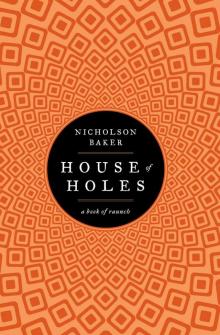 House of Holes
House of Holes Checkpoint
Checkpoint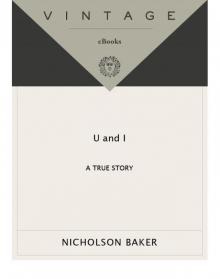 U and I
U and I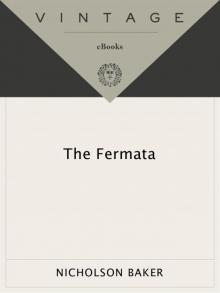 The Fermata
The Fermata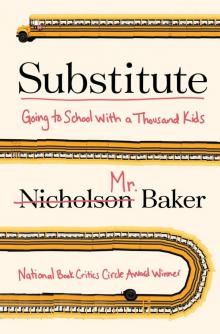 Substitute
Substitute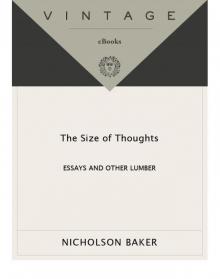 The Size of Thoughts
The Size of Thoughts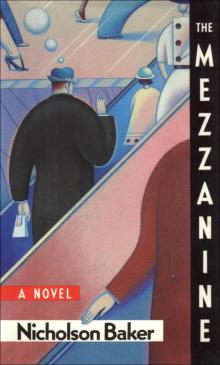 Mezzanine
Mezzanine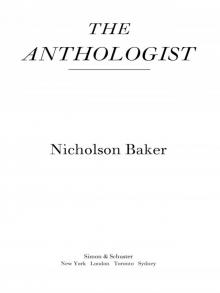 The Anthologist
The Anthologist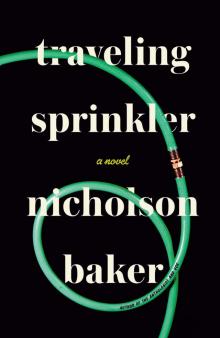 Traveling Sprinkler
Traveling Sprinkler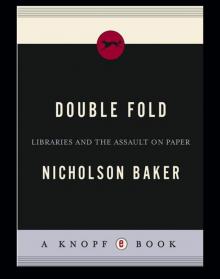 Double Fold
Double Fold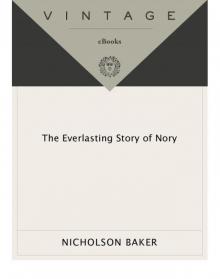 The Everlasting Story of Nory
The Everlasting Story of Nory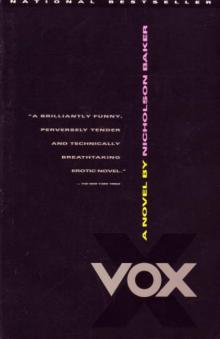 Vox
Vox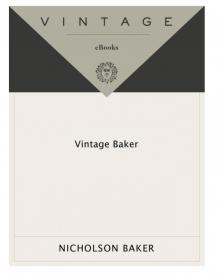 Vintage Baker
Vintage Baker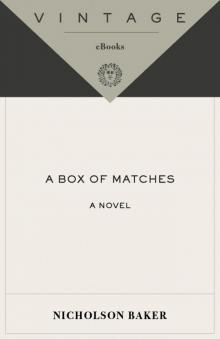 A Box of Matches
A Box of Matches